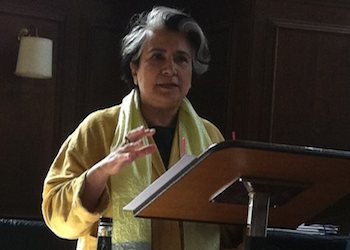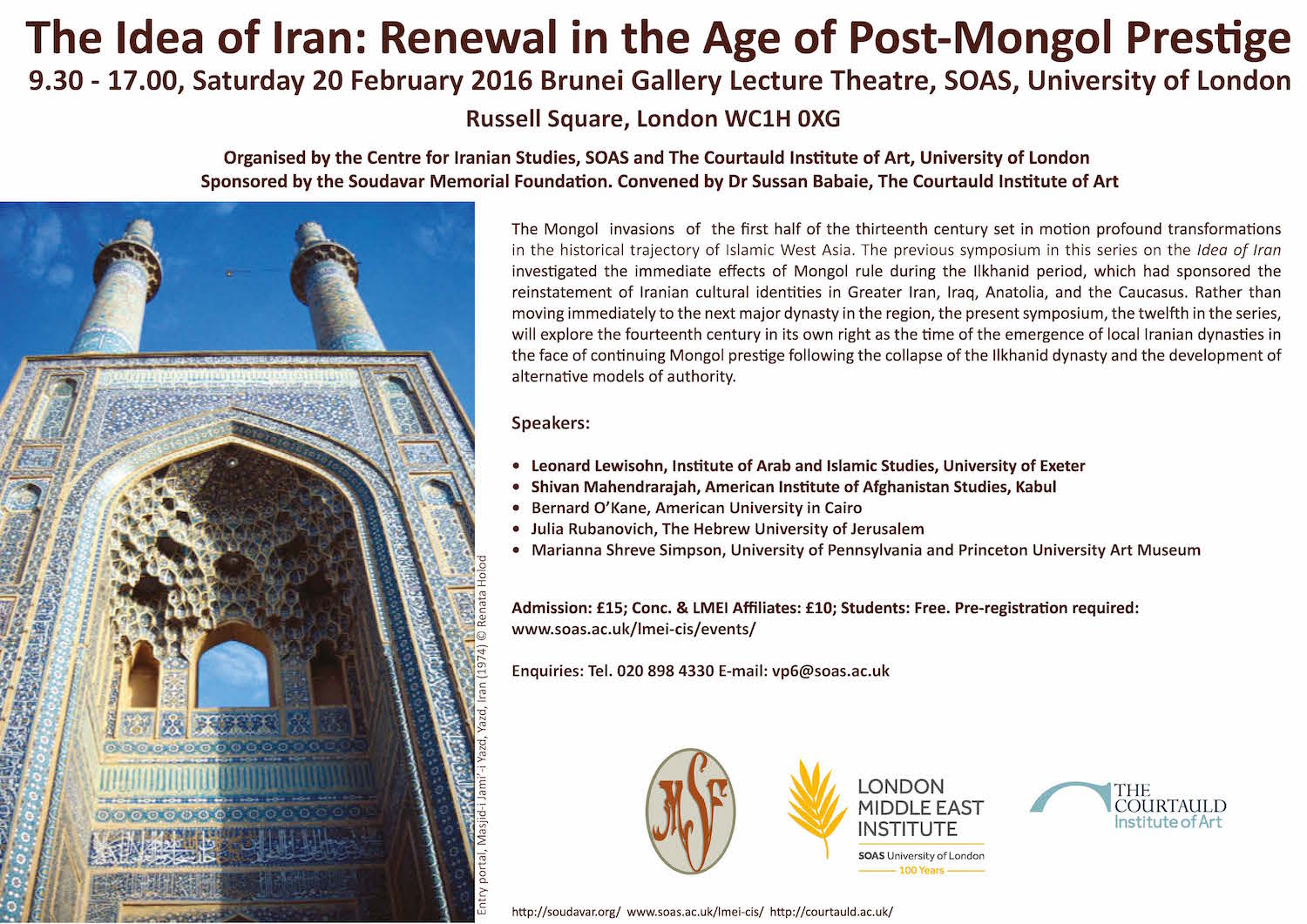The Idea of Iran: Renewal in the Age of Post-Mongol Prestige
he Mongol invasions of the first half of the thirteenth century set in motion profound transformations in the historical trajectory of Islamic West Asia. The previous symposium in this series on the Idea of Iran investigated the immediate effects of Mongol rule during the Ilkhanid period, which had sponsored the reinstatement of Iranian cultural identities in Greater Iran, Iraq, Anatolia, and the Caucasus. Rather than moving immediately to the next major dynasty in the region, the present symposium will explore the fourteenth century in its own right as the time of the emergence of local Iranian dynasties in the face of continuing Mongol prestige after the collapse of the Ilkhanid dynasty, and the development of alternative models of authority.
This period is often touched upon only lightly in overview studies, partially because of the comparative scarcity of the sources, and partially because its story is not an easy one to tell, because there is not a single regional polity and dynasty whose trajectory one could follow: By the mid‐1330s, the Ilkhanate in Iran made place to regional successor polities, resulting in a multicephalous cultural, political, and religious landscape, with many regional centers. Each of these made distinct cultural contributions, the most prominent ones during this time being the Jalayirids, Muzaffarids, Sarbadars and Karts. The Persian language, already dominant in the literary sphere, was used increasingly also for administrative, historical and scientific writing. Buildings, including the urban developments in Tabriz, Yazd, Shiraz, and Herat, and manuscripts, especially of the Shahnameh and its imitations continued to be produced for princely patrons with aspirations to don the Iranian crown of kingship.
It is also during this period that we witness the peak of productivity of several of the greatest Persian poets, including Khwaju‐yi Kermani (d. 1341 or 1352), Ubayd‐i Zakani (d. 1371), as well as Hafez (d. 1389), who wrote some of the greatest masterpieces of Persian poetry. Several major historians were active during this period, such as Hamdullah Mustawfi (fl. 1335), Muʾin al‐Din Yazdi (fl. 1356) and Nezam al‐Din Shami (fl. 1404). The fourteenth century was extremely important in the realm of intellectual history as well, producing such major theologians as ʿAdud al‐Din al‐Iji (d. 1355), Saʿd al‐Din Taftazani (d. 1390), and Sayyid Sharif Jurjani (d. 1413), who were mostly active in Fars, especially Shiraz, and the Khurasan region. Several prominent Sufi figures, eponyms of important socio‐political movements and Sufi tariqas, such as Bahaʾ al‐Din Naqshband (d. 1389), Fazl Allah Astarabadi (d. 1394), and Shah Neʿmat Allah Vali (d. 1430), lived and worked in this period, and it is also during this period that we observe the rise and consolidation of distinct Sufi groups with origins in the thirteenth century, such as the Mawlaviyya, Kubrawiyya, and Safaviyya.
This symposium explores the cultural complexities of reinventing the idea of Iran during the period of extreme political decentralization, focusing on aspects of cultural longevity and fluid transformations in light of the competing cultural, political, and religious aspirations in the post‐Mongol world.
**Due to unforeseen circumstances Professor Richard Davis is now unfortunately unable to participate in this year’s symposium**
Organiser: Centre for Iranian Studies and The Courtauld Institute of Art
Sponsor: Soudavar Memorial Foundation
Speakers
The Iranian Interlude: From Mongol Decline to Tamerlane’s Invasion
Shivan Mahendrarajah, Research Fellow, American Institute of Afghanistan Studies, Kabul
Three periods characterize Iran between Mongol and Turkic domination: 1220-78, when Iran was attacked and exploited by the Mongols; the years 1278-1335, where social and economic uptrends were evident; and 1335-81, where concomitant with the decline of Ilkhanid rule, independent regional polities, Turk and Tajik, Sunni and Shi‘a, manifested across Iran. This was the ‘Iranian interlude,’ and terminated by Tamerlane in 1381. As with the ‘Iranian intermezzo,’ this critical interlude witnessed continuities and changes via emerging polities. The Karts of eastern Khurasan (r. 1245-1381), and the Sarbadars of western Khurasan (r. 1336-81), reveal competing vehicles for ‘the idea of Iran’: the Kartid state’s self-image was of a ‘traditional’ Persian Padishah protecting Iran from Turan (the Chaghatay) and Islam from Shi‘ism (the Sarbadars). Meanwhile, the Sarbadars, of iconoclastic and confessionally ambiguous beginnings, evolved into a resolutely Twelver Shi‘a Iranian state.
Sufism in Late Mongol and Timurid Persia, from ‘Ala’ al-Dawla Simnani (d. 736/1326) to Shah Ni‘matullah Wali (d. 835/1431)
Leonard Lewisohn, Senior Lecturer in Persian and Iran Heritage Foundation Fellow in Classical Persian and Sufi Literature, Institute of Arab and Islamic Studies, University of Exeter
This lecture is divided into six parts. In part one, an overview of the social situation of Sufism in fourteenth- and fifteenth-century Persia is given, in which the political relations between Sufis and various Mongol and Timurid princes and their courts, conflicts between exoteric Shari‘a-minded clerics and Sufis, and the spread of the Khanaqah institution through greater Persia are summarized. In part two, various schools of Sufi theosophy in medieval Persia are examined, with a focus on the school (and Iranian followers) of Ibn ‘Arabi (d. 638/1240) and the legacy of Rumi’s Mathnawi and Divan-i Shams throughout greater Persia. In the third part, the rise and spread of the Persian Orders (ṭariqas) during this period will be analysed, focusing primarily on the Kubrawiyya, Naqshbandiyya, Kaziruniyya, Suhrawardiyya, Qadiriyya, Mawlawiyya and Yasiwiyya. In part four, the key Persian Sufi prose texts of the period will be surveyed, followed in part five by an overview of the key Persian Sufi mathnawi and ghazal poets of the period, from ‘Ala’ al-Dawla Simnani (d. 736/1326) down to Shah Ni‘matullah Walii(d. 835/1431) and his followers such as Shah Qasim-i Anwar (d. 837/1433) and Shah Da’i Shirazi (d. 869-70/1464-65). In part six, I offer tentative conclusions about why some of the teachings and doctrines of fourteenth- and fifteenth-century Persian Sufism—viz. its ‘Religion of Love (madhhab-i ‘ishq), its humanistic ethics, its theories of symbolism, metaphysical imagination and Unity of Being, its tolerant ecumenical and anti-clerical teachings—remain timelessly relevant to the ‘Idea of Iran’ today.
Persian Narrative Poetry in the Fourteenth to Early Fifteenth Centuries and the Legacy of Firdausi’s Shahnama
Julia Rubanovich, The Hebrew University of Jerusalem
The presentation offers a review of Persian narrative poetry of the fourteenth to early fifteenth centuries from the standpoint of its intertextual relationship with Firdausi’s Shahnama. Four major tendencies are discernible in the evolution of the epic’s reception in the period discussed: a direct continuation of the Shahnama’s thematic and stylistic patterns in a genre of historical-heroic epic with a growing admixture of religious – Islamic and Sufi – elements; a partial and mediated adoption of the heroic-epic tradition epitomised in the Shahnama, where Nizami’s romantic poem on the one hand, and the so called ‘secondary epics’ complementing the Sistani cycle on the other, act as intermediaries; a satirical emulation of Firdausi’s work and the Shahnama tradition as an impetus for the development of classical Judeao-Persian epic literature. The speaker will examine the literary and historical reasons behind the development of the above-mentioned tendencies, focusing on their interrelationship and interplay.
Reprising the Question: Why was the Shahnama Illustrated?
Marianna Shreve Simpson, Scholar, University of Pennsylvania and Guest Curator, Princeton University Art Museum
The 2010 millennial celebration of Firdausi’s epic poem occasioned an outpouring of publications and exhibitions, and attracted scholarly and public attention alike. Five years on, interest in the Book of Kings remains unabated, as evidenced by ever more articles, entire journal issues, collected studies, monographs, and catalogues. This presentation takes a historiographic look at both recent twenty-first and late-twentieth-century scholarship on the illustrated Shahnama tradition in an attempt to sort out perspectives on the still-changing question of how – and especially why – this iconic work of Persian literature developed into deluxe works of Persian art during the Ilkhanid and later periods.
The Jalayirid and Muzzaffarid Architecture of Iran
Bernard O’Kane, Professor of Islamic Art and Architecture, American University in Cairo
Sandwiched between the Ilkhanids and the Timurids, the Muzzaffarids do not usually receive much credit for their architectural patronage. However, their innovations in vaulting and in decoration, particularly in tilework, deserve to place them in the first rank of benefactors. This presentation will explore some of these topics in the architecture of Isfahan, Yazd and Kerman, particularly with regard to the Friday mosques of these cities. The evidence for domestic architecture of the Muzzaffarids in Yazd will also be considered. It will also be argued that the tomb of Shaykh Safi and the Dar al-Huffaz at Ardabil should be re-dated to the Jalayirid period, from the second rather than the first half of the fourteenth century as has often been thought.
Convenor

Dr Sussan Babaie is the Andrew W. Mellon Lecturer in the Arts of Iran and Islam at the Courtauld Institute of Art, University of London, President of the Historians of Islamic Art Association, and serves on the Governing Council of the British Institute of Persian Studies, the Board of Directors of the Association for the Study of Persianate Societies and is a Trustee-at-Large of the American Institute of Iranian Studies. She has many years of experience teaching, both in the States at Smith College and the University of Michigan, and in Germany as a Visiting Professor at the Institut für Kunstgeschichte, Ludwig Maximilian University, in Munich. Her research and teaching concern questions of imperialism and artistic patronage in Persianate West, Central and South Asia where high culture derived from the literary corpus of the Persian language.


